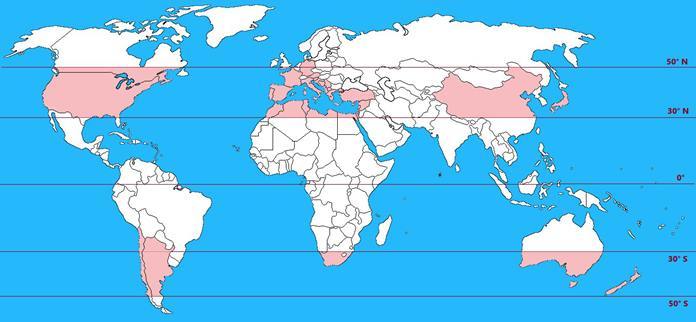
If you wander through the wine section of a typical supermarket you might get the impression that wine comes from all over the world. But you’d be wrong. The bulk of the world’s wine originates from grapes grown between 30 and 50 degrees of latitude in both the Northern and Southern hemispheres. The Northern Hemisphere is by far the larger wine producer because this band covers much more land, whereas the Southern 30-50 degree band is mostly over oceans.
But perhaps you have forgotten what “latitude” means, especially if your geography is a bit hazy. So let me explain. On a map or globe of the Earth, latitude is shown by imaginary horizontal lines like hula hoops around the surface from the equator to the two poles. On a map, like the one shown here, they appear as straight lines. They’re sometimes called “parallels” because they run parallel to the equator which is the starting point for measuring latitude so it’s considered as zero degrees. Thailand is comparatively near the equator and Pattaya lies 12° North. One degree of latitude is around 69 miles (or 110 kms) so Chiang Mai is almost 19° N. London is about 51.5° N whereas on the opposite side of the world, Sydney is about 35° South (usually shown as -35°). This of course is within the southern grape-growing comfort zone.
The vertical lines on a map or globe indicate longitude and knowing both these values you can pin-point anywhere on the globe. This is partly how your GPS device works. Surprisingly perhaps, the concepts of latitude and longitude have been known since ancient times. Mariners of old could determine their latitude from the position of the sun, or at night from the positions of the stars. Finding longitude however, proved a spectacularly difficult problem. In 1707 the British Government offered a reward of twenty thousand pounds (equivalent to four million dollars in 2020) to anyone who could devise an accurate way of accurately determining longitude. But that’s another story. And a good one, too.
But back to wine. Fifty years ago, it was assumed that wine grapes would grow only between 30 and 50 degrees and nowhere else. We know now that grapes can grow far beyond this range in places like India, Vietnam, Indonesia and Namibia. In the 1980s Thailand pioneered wine production in a narrow band between 14-18°N. Today several Thai wineries are producing award-winning wines from grapes grown at these latitudes.
Latitude is only part of a complex equation. The wine in your glass is the result of several other factors such as climate, weather, soil, terrain and wine-making techniques. These are often described as terroir (tair-WAH) a convenient French word for which there is no exact English equivalent. Merlot grown in Bordeaux doesn’t taste the same as Merlot grown in the Napa Valley because the terroir is different. Climate is critical too and you’ll hear expressions like “cool” and “hot” climate wines. Generally speaking, cool climate wines tend to be light bodied with low alcohol, crisp acidity and bright fruit flavors. Hot climate wines are usually fuller bodied with higher alcohol, softer acidity and more lush fruit flavours. So you see, your personal choice of wine might depend largely on climate.
Confused about climate and weather? The American writer Robert A. Heinlein has the answer: “Climate is what you expect, weather is what you get.” Few would disagree that our climate is changing and this has an impact on viticulture. Eric Asimov is the wine columnist for the New York Times. Last year he wrote, “Grape growers especially have been noting profound changes in weather patterns since the 1990s. In the short term, some of these changes have actually benefited certain regions.” He is right. While some wine areas have recently experienced drought, heat waves and unexpected hail, others have been more fortunate. For example, top quality English sparkling wine was unheard of in the 1980s but today’s warmer climate is allowing English wine-makers to produce world-class sparklers using the méthode champenoise. Not surprisingly, new vineyards are being planted with enthusiasm in England’s southern counties.
Climate change is providing opportunities for more northerly regions to develop a wine industry and grapes are now being planted in Belgium, Denmark, Norway, Sweden and even Finland. Thirty years ago, only a lunatic would have contemplated planting grapes at 59° N.
Winemakers have another problem relating to climate change. Higher temperatures cause grapes to ripen earlier. The sugar in the grapes turns into alcohol too quickly before the all-important phenols have had sufficient time to develop. These phenols include several hundred chemical compounds that enhance the colour, taste and mouth-feel. Wine-makers now have to decide whether to harvest grapes early, producing wine with acceptable alcohol levels but with less interest and complexity. The alternative is to leave the grapes on the vine and wait for the development of the phenolic compounds, risking wine which is too high in alcohol.
And in case you’re wondering, the wine industry produces only about 0.1 percent of global carbon emissions. Now if you ask me that’s welcome news. Perhaps we should open another bottle.
 |
 |
 |





